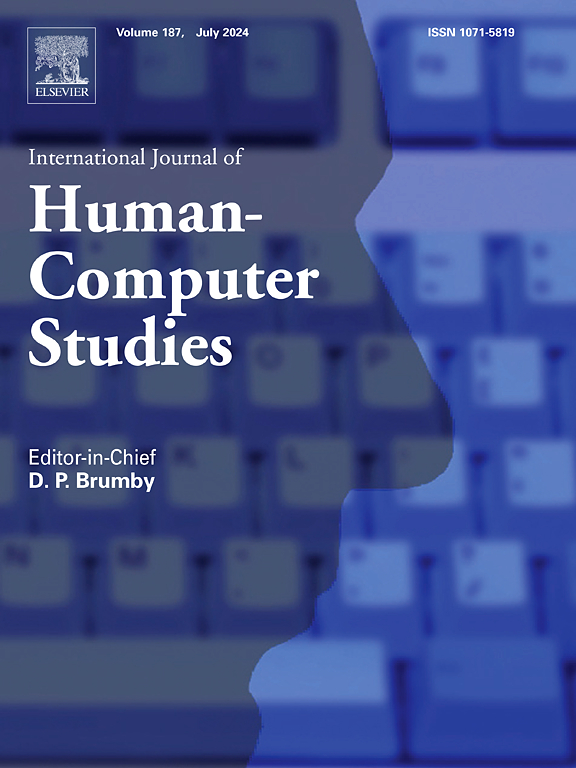将增强现实与 LLM 相结合,增强关键音频通信中的认知支持
IF 5.3
2区 计算机科学
Q1 COMPUTER SCIENCE, CYBERNETICS
International Journal of Human-Computer Studies
Pub Date : 2024-11-06
DOI:10.1016/j.ijhcs.2024.103402
引用次数: 0
摘要
运行与维护(O&M)任务通常具有时间敏感性和精确性,需要在嘈杂混乱的环境中快速精确地处理信息,而在这种环境中,口头交流可能会导致认知超载和决策受损。增强现实(AR)和大型语言模型(LLMs)通过将数字可视化与物理世界相结合并改进对话管理,为增强态势感知和降低认知负荷提供了潜力。然而,如何将这些技术整合到实时系统中,为操作员提供有效帮助,仍然是一项挑战。本研究探讨了将 AR 和 GPT-4(一种先进的 LLM)整合到时间敏感的 O&M 任务中,旨在增强口语交流过程中的态势感知和管理认知负荷。一个定制的 AR 系统结合了用于认知监控的 Microsoft HoloLens2 和用于辅助决策的 GPT-4,在一项有 30 名参与者参加的人体实验中进行了测试。该 2×2 因式实验评估了 AR 和 LLM 辅助对任务表现和认知负荷的影响。结果表明,任务准确性有了明显提高,认知负荷也有所减轻,这凸显了 AR 和 LLM 集成在支持 O&M 任务中的有效性。这些发现强调了进一步研究的必要性,以优化关键任务环境中的操作策略。本文章由计算机程序翻译,如有差异,请以英文原文为准。
Integrating augmented reality and LLM for enhanced cognitive support in critical audio communications
Operation and Maintenance (O&M) missions are often time-sensitive and accuracy-dependent, requiring rapid and precise information processing in noisy, chaotic environments where oral communication can lead to cognitive overload and impaired decision-making. Augmented Reality (AR) and Large Language Models (LLMs) offer potential for enhancing situational awareness and lowering cognitive load by integrating digital visualizations with the physical world and improving dialogue management. However, synthesizing these technologies into a real-time system that effectively aids operators remains a challenge. This study explores the integration of AR and GPT-4, an advanced LLM, in time-sensitive O&M tasks, aiming to enhance situational awareness and manage cognitive load during oral communications. A customized AR system, incorporating the Microsoft HoloLens2 for cognitive monitoring and GPT-4 for decision making assistance, was tested in a human subject experiment with 30 participants. The 2×2 factorial experiment evaluated the effects of AR and LLM assistance on task performance and cognitive load. Results demonstrated significant improvements in task accuracy and reductions in cognitive load, highlighting the effectiveness of AR and LLM integration in supporting O&M missions. These findings emphasize the need for further research to optimize operational strategies in mission critical environments.
求助全文
通过发布文献求助,成功后即可免费获取论文全文。
去求助
来源期刊

International Journal of Human-Computer Studies
工程技术-计算机:控制论
CiteScore
11.50
自引率
5.60%
发文量
108
审稿时长
3 months
期刊介绍:
The International Journal of Human-Computer Studies publishes original research over the whole spectrum of work relevant to the theory and practice of innovative interactive systems. The journal is inherently interdisciplinary, covering research in computing, artificial intelligence, psychology, linguistics, communication, design, engineering, and social organization, which is relevant to the design, analysis, evaluation and application of innovative interactive systems. Papers at the boundaries of these disciplines are especially welcome, as it is our view that interdisciplinary approaches are needed for producing theoretical insights in this complex area and for effective deployment of innovative technologies in concrete user communities.
Research areas relevant to the journal include, but are not limited to:
• Innovative interaction techniques
• Multimodal interaction
• Speech interaction
• Graphic interaction
• Natural language interaction
• Interaction in mobile and embedded systems
• Interface design and evaluation methodologies
• Design and evaluation of innovative interactive systems
• User interface prototyping and management systems
• Ubiquitous computing
• Wearable computers
• Pervasive computing
• Affective computing
• Empirical studies of user behaviour
• Empirical studies of programming and software engineering
• Computer supported cooperative work
• Computer mediated communication
• Virtual reality
• Mixed and augmented Reality
• Intelligent user interfaces
• Presence
...
 求助内容:
求助内容: 应助结果提醒方式:
应助结果提醒方式:


